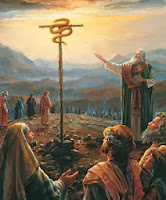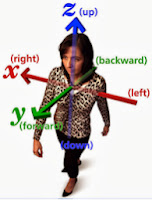Continuing from the last posts
showing the fallacy of the Mesoamerican Theorists’ view of the Isthmus of
Tehuantepec in being the narrow neck of land—it becomes clear that this isthmus
is the real Achilles heel of every Mesoamerican model. In pursuing this, the
following is from John E. Clark, himself a Mesoamericanist and follower of John
L. Sorenson’s model, in which he defends the Mesoamerican Theory.
Clark’s arguments continue:
14. “The description of poisonous
snakes blocking passage to the land southward in Jaredite times is one of the
more unusual claims in the Book of Mormon. I agree with Warr that the incident
indicates warm climes and favors the interpretation of the narrow neck as an
isthmus rather than a corridor. Beyond this, there is not much that we can
wring from this description. John Tvedtnes suggests that the snakes could have
been associated with drought and infestations of small rodents,
something that could have occurred in either area. Poisonous snakes are
probably prevalent in both proposed areas. For now, this criterion does not
favor either proposal. For his part, Allen reads these passages metaphorically
to refer to secret societies; he claims that a literal reading is nonsensical.”
Response: First of
all, the Children of Israel were being bitten and killed by a huge number of snakes, so many in fact, that they infested the tens of thousands of Israelites in the wilderness (Numbers 21:6), which should suggest that the Lord has used snakes for his purposes more than just in the Book of Mormon. Secondly, a warm clime would fit Mesoamerica, the Rivas Isthmus, and also the Bay of
Guayaquil in Ecuador, South America (nearer the Equator than the other two), so that idea is not helpful
for a location. Secondly, there is nothing about the event that suggests an
isthmus over a corridor. However, the word isthmus (defined as “a narrow strip
of land with sea on either side, forming a link between two larger areas of
land”) certainly seems to be more accurate than corridor; however, since this
narrow neck of land had a “narrow passage” (Mormon 2:29), a synonym of corridor
is passage, but not pass, which this area is also called by Mormon (Alma 50:34,
52:9). So why don’t we stick with Mormon’s term “neck of land,” rather than
inserting Isthmus, especially since Mesoamericanists and James Warr both prefer
that term because their models are called an Isthmus (of Tehuantepec and of
Rivas).
As for “one of the
most unusual claims,” perhaps we should consider the purpose of this
action—it kept the Jaredites from entering the Land Southward (Ether 9:32-33).
Evidently, the Lord did not intend for the people to do so, and the snakes were
his way of keeping the Jaredites in the Land Northward “but that they
should hedge up the way that the people
could not pass” (Ether 9:33). And as for “John
Tvedtnes suggests that the snakes could have been associated with drought and
infestations of small rodents,” certainly this was because of drought,
since their was “a great dearth upon the land, and the inhabitants began to be
destroyed exceedingly fast because of the dearth, for there was no rain upon
the face of the earth” (Ether 9:30). Since a dearth is a lack of something, and
there was no rain upon the land, one would normally consider that a drought. And
with a lack of rain, this usually leads to a lack of food crops, so there was a
famine. This is not rocket science, and John Tvedtnes making the statement that
“the snakes could have been associated with a drought,” and Clark even quoting
that, seems on the ridiculous side. Certainly the idea of rodents, since there
is no mention or suggestion of such in the scriptural record, is equally
ridiculous to bring up. But as long as it was brought up, one of the favorite
meals of large snakes is small rodents, so it is not likely they would have
escaped the horde of snakes, and meaningless to bring up. The point is, it is
not wisdom to invent ideas not specifically mentioned or suggested by the
scriptural record—it does nothing for the student of the scriptures, and often
creates a false knowledge that serves little or no purpose.
15. “A careful reading of [Ether 9:35] may cause
questions to arise. Neither serpents nor flocks behave in the manner described
here. That is, poisonous serpents do not pursue animals; they defend themselves
against intruders including animals.”
Response: The key
here is the term: “The Lord did cause the serpents that they should pursue them
no more” (Ether 9:33), which should suggest that the Lord caused the serpents
to pursue them in the first place. Most importantly, we need to understand that
neither Mormon nor Joseph Smith used the term snakes, but serpents. A serpent
is a large snake, and if large enough, many animals would move away from them.
If the serpents were inclined to attack, an attitude that could have been
installed in them by the Lord, the animals would have fled. This brings to mind
when “the Lord sent fiery serpents among the people and they bit the people”
and the Lord told Moses hold up the pole with a brass serpent on
it (Numbers 21:8). It seems to me that there are no questions that need arise.
We need to trust in the prophets who wrote the scriptural record, and know that
nothing is too difficult for the Lord (Jeremiah 32:27).
16. “Additionally, if
in reality the flocks represent sheep or cattle, it is contrary to the way
these animals react. They simply do not travel hundreds of miles just to get
away from snakes…If the serpents and flocks represent groups of people instead
of animals, the scripture in Ether 9:31 takes on an entirely different meaning.
The poisonous serpents may be symbolic of the secret combinations, which did
"poison many people" (Ether 9:31). This is exactly how secret
combinations work. They spread their deadly poison among the people. They draw
them away by false promises for the sole purpose of obtaining power over the
masses and to get gain. Hence, the flocks could represent a righteous group of
people who retreated to the Land Southward to escape the wickedness that had
come upon the land. The word "flocks" is used in many instances in
the scriptures to represent a righteous group of people. Indeed, the Savior is
the Good Shepherd who watches over His flocks (Alma 5:59 60).”
Response: This is
very imaginative and reminds me of types of Sunday School discussions that
stray far afield of the scripture under discussion. On the other hand, most
scripture is symbolic and meant to point one toward Christ. Unfortunately, that
is no interpretation in the scriptural record to suggest such a meaning. And certainly the fiery serpents
mentioned in Numbers was tied directly into the pole and serpent Moses held up,
since the pole and serpent, when looked upon, saved the people, which is an
obvious suggestion of how looking upon Christ, the one that was lifted up on
the cross, results in our salvation. In this quote Clark attributes to Joseph
Allen’s book, evidently Clark and I agree since he goes on to state: “There is no indication in the
text that this verse should be read metaphorically to refer to secret
combinations.” In addition, we might consider that the Lord, who controls all things, evidently wanted flocks, herds, etc., to enter into the Land Southward during Jaredite times, so they would multiply and cover the Land Southward for the future needs of the Lehi Colony and the Nephite nation. It is always amazing when people start limiting what the Lord can and does do to further his plans.
17. “In discussions of
Nephite demography…it is now commonplace to make the observation that Lehites
and Mulekites were not alone on the continent. The same was true for the
Jaredites.”
Response: It is certainly commonplace among those who
champion Mesoamerica as the Land of Promise site. However, and once again,
since there is not a single reference of any kind in the scriptural record that
the Land of Promise was occupied by anyone other than Lehi’s family, the
Jaredites before them, and the Mulekites, it seems less than prudent to keep
harping on the unfounded belief that the area described in the Book of Mormon
was occupied by anyone between the Flood rescinding and the coming of the
Jaredites and later the Lehi colony. Those who do so sound like the proverbial "used-car salesman" of an earlier era who kept telling tall tales about his product that eventually the customer believed him. Such an approach falls under the also proverbial statement that come out of World War II, "if you tell a lie often enough it will be believed." There simply were no other people in the Land of Promise according to all the prophets who wrote about their land. Of course, it is completely self-serving
for Mesoamericanists to keep claiming this.
(See the next post,
“The Narrow Neck of Land One More Time – Part XIII—Mesoaermicanists’ Achilles
Heel,” for more on this difficult area for the Mesoamerican Theorist model to
reconcile with the scripture)




























